Trending
Opinion: How will Project 2025 impact game developers?
The Heritage Foundation's manifesto for the possible next administration could do great harm to many, including large portions of the game development community.

Featured Blog | This community-written post highlights the best of what the game industry has to offer. Read more like it on the Game Developer Blogs or learn how to Submit Your Own Blog Post
First of a 2-part series. Game composer Winifred Phillips delves into the dynamic music system for the recently-released SPYDER video game, developed by Sumo Digital for Apple Arcade. Part 1 explores the ambient system (including many video examples).

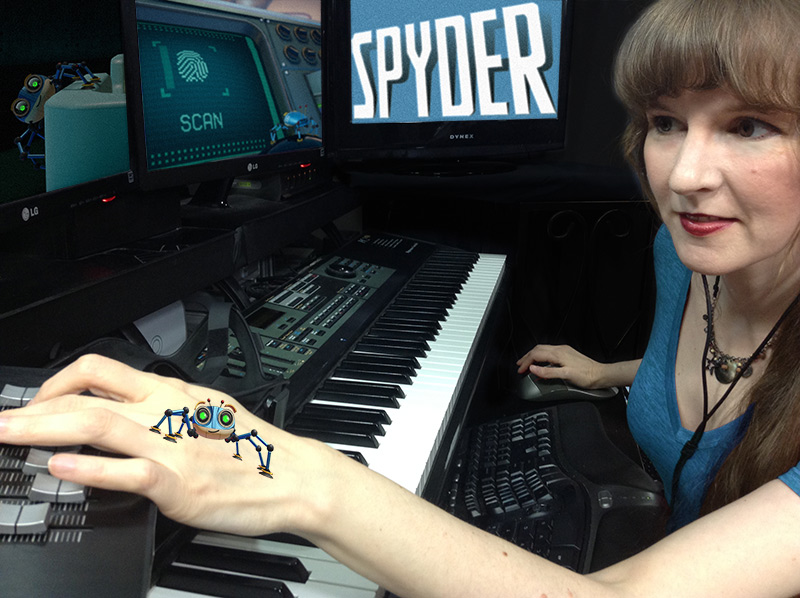
By Winifred Phillips | Contact | Follow
Hello there! I'm video game composer Winifred Phillips, and I'm excited to announce the release of my most recent video game project – Spyder, developed by Sumo Digital for the popular Apple Arcade gaming platform. I loved working with the amazing audio team at Sumo Digital, and composing the music of Spyder was an absolute blast! As a retro spy thriller with a really iconic visual aesthetic, Spyder gave me the chance to delve into the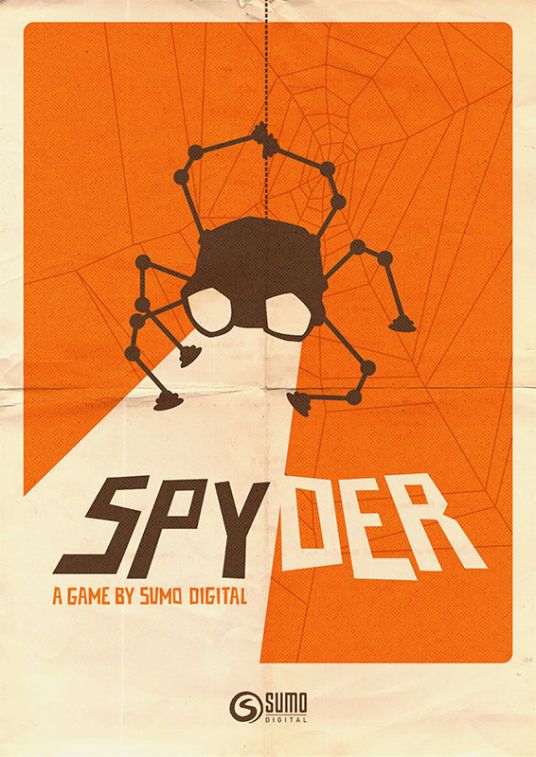 musical styles of the late sixties and early seventies. Big band jazz of the 50s had evolved over time into a groovy psychedelic circus of 1960s musical fun. Mix this with the beginnings of 70s funk – and early synthetic sounds such as the famous Minimoog – and you end up with a potent cocktail of musical influences and attitudes. All of this retro goodness is reflected in the old-school movie-style poster created by the Sumo Digital team to announce the Spyder video game (pictured right).
musical styles of the late sixties and early seventies. Big band jazz of the 50s had evolved over time into a groovy psychedelic circus of 1960s musical fun. Mix this with the beginnings of 70s funk – and early synthetic sounds such as the famous Minimoog – and you end up with a potent cocktail of musical influences and attitudes. All of this retro goodness is reflected in the old-school movie-style poster created by the Sumo Digital team to announce the Spyder video game (pictured right).
The historical research into style, technique and instrumentation posed a significant challenge for me as a game music composer. In the course of preparing to compose the music for Spyder, I sank an enormous amount of time into this research, listening to what felt like every single spy movie soundtrack from the late sixties and early seventies. I also listened to tons of straight action movie soundtracks from the same era, as well as a great assortment of comedies, all while taking copious notes. Lending a strong sense of authenticity to the era was a crucial responsibility of the game music that would give Spyder its evocative character.
Here's a taste of the results of that research – the main theme tune. Spyder is a highly-thematic score, with a pervasive main melody that appears in countless variations throughout the game. Here's how that melody sounds in the game's launch trailer:
On top of the challenges posed by the required research, I also had to wrap my head around the interactive music system for Spyder, which pulled together a complex matrix of musical components that flowed seamlessly into a cohesive and extensively dynamic musical score. The system had a lot of moving parts, which made for a very complicated process during the composition and production of the musical score. With that in mind, I thought it would be interesting and fun for us to take a closer look at how the dynamic music of Spyder is constructed and implemented across the game.
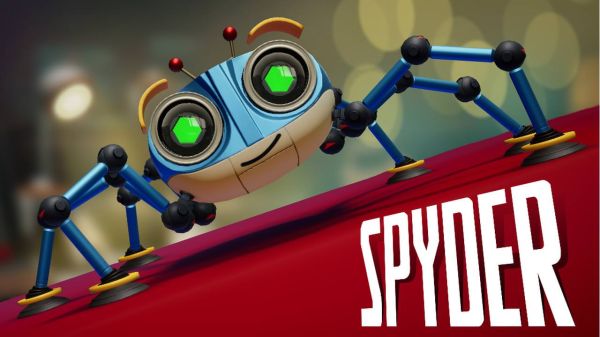 Spyder includes two dramatically different implementation schemes for musical interactivity, and each music design is deployed strategically as gameplay progresses across each level. In this article, I thought we'd take a look at the more laid-back, ambient music system that typifies Spyder's score during exploration gameplay. Next month I'll be posting another article that will explore the higher-energy action music that gradually takes over as players progress through each level and the stakes get higher.
Spyder includes two dramatically different implementation schemes for musical interactivity, and each music design is deployed strategically as gameplay progresses across each level. In this article, I thought we'd take a look at the more laid-back, ambient music system that typifies Spyder's score during exploration gameplay. Next month I'll be posting another article that will explore the higher-energy action music that gradually takes over as players progress through each level and the stakes get higher.
But first, let's get acquainted with the game's titular hero, as described by the talented folks at Sumo Digital. "Set in a retro universe, British Spy Agency ‘EP-8’ has created Agent 8, the most sophisticated miniature robot spider on earth! Built using experimental technology, this itsy-bitsy superspy is equipped with all the gadgets and gizmos you’ll need; cut through panels, overload terminals, flip switches, and open valves as you scurry about sabotaging the heinous plans of evil doers."
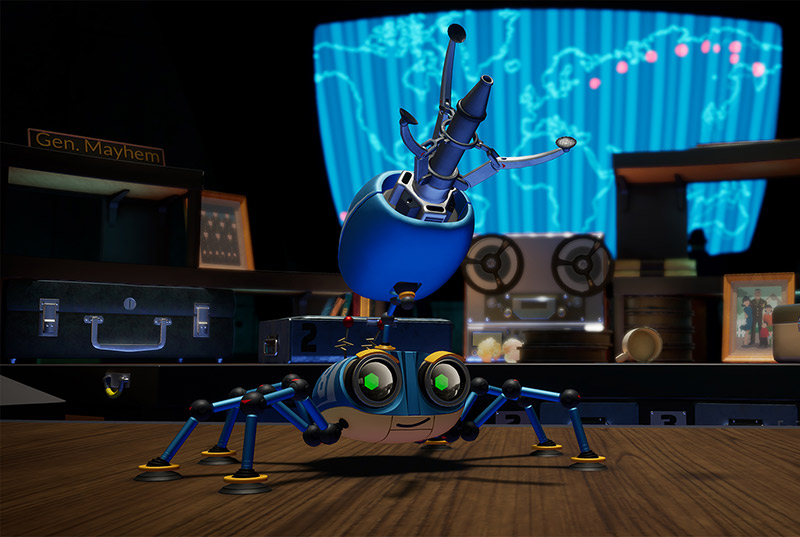 So, as you could see from the game's launch trailer, Spyder is a spy thriller with a twist. In Spyder, you don't play the expert super-agent with all the awesome intelligence-gathering devices... you play as one of those devices. This allows the game to turn the spy genre upside-down – sometimes quite literally. During the course of the game, Agent 8 completes stealthy missions while crawling across the underside of tables in a secret military base, clinging to the bottom of a speeding train, and even inching across the underbelly of a space capsule hurtling through the inky void.
So, as you could see from the game's launch trailer, Spyder is a spy thriller with a twist. In Spyder, you don't play the expert super-agent with all the awesome intelligence-gathering devices... you play as one of those devices. This allows the game to turn the spy genre upside-down – sometimes quite literally. During the course of the game, Agent 8 completes stealthy missions while crawling across the underside of tables in a secret military base, clinging to the bottom of a speeding train, and even inching across the underbelly of a space capsule hurtling through the inky void.
Speaking of the inky void, it makes sense for us to begin our discussion of the music system of Spyder by focusing on the outer-space level of the game. The Spyder video game has two different models of ambient music implementation. Since one of these ambient music systems is essentially built onto the framework of the other, I thought it would be best to start with the simpler of the two systems and then progress to the more complicated design. So, let's go to space, shall we?
The Space Invaded level finds our eponymous hero launched beyond the bounds of Earth on a space capsule that's been sabotaged. It's Agent 8's job to repair the capsule and help the astronauts return safely to Earth. The level opens with our hero navigating a series of damaged fuel lines, making repairs in order to direct fuel to the booster rockets. Gameplay in this level consists of carefully retrieving segments of fuel pipe that have been dislodged, and then fitting the pieces back into the mechanism.
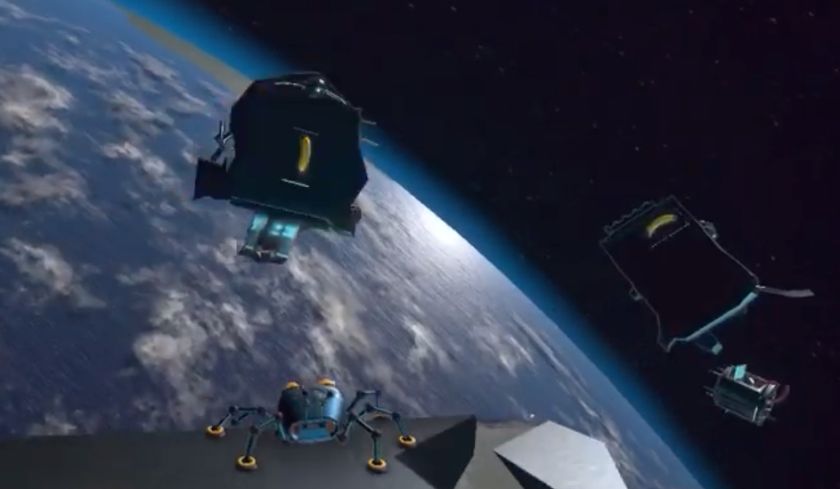 The music design for the puzzle-solving sequence in Space Invaded focuses on a modular system of over 30 atmospheric music segments created for the puzzle gameplay of this one particular level. These segments were designed to be triggered in an unpredictable, reshuffled sequence while the fuel line is being repaired. In order to make this work, my first job was to create a large assortment of discrete ambient compositions that would be steeped in the musical vocabulary of the era, while also being suitable for a spy adventure in outer space. Each musical segment had to be created so that it could be essentially disassembled and then pulled back together, allowing the game to trigger two distinct versions of each musical segment. Then, the music system could trigger these compositions in a semi-random implementation scheme that would enable the musical intensity to scale upwards as more tasks were completed.
The music design for the puzzle-solving sequence in Space Invaded focuses on a modular system of over 30 atmospheric music segments created for the puzzle gameplay of this one particular level. These segments were designed to be triggered in an unpredictable, reshuffled sequence while the fuel line is being repaired. In order to make this work, my first job was to create a large assortment of discrete ambient compositions that would be steeped in the musical vocabulary of the era, while also being suitable for a spy adventure in outer space. Each musical segment had to be created so that it could be essentially disassembled and then pulled back together, allowing the game to trigger two distinct versions of each musical segment. Then, the music system could trigger these compositions in a semi-random implementation scheme that would enable the musical intensity to scale upwards as more tasks were completed.
So let's see how that worked, shall we? When Agent 8 is first dropped into the level, he's introduced to the "Repair for Re-Entry!" mission, in which he's tasked with collecting detached pipe lengths and returning them to the fuel line system. Music during this gameplay is triggered in random order, so that players rarely encounter the same musical sequence twice when restarting checkpoints or replaying missions. This short video demonstrates one of the simple music segments designed to accompany early puzzle gameplay:
So as you could hear, this simple environmental motif consists of a few notes to set the scene, along with a pulsing bassline and some atmospheric synthetic textures.
As gameplay progresses, Agent 8 eventually reaches the "Burning Through the Sky!" mission in which he enters the space capsule, seals the hatch and accesses the navigation computer to help the astronauts land their crippled vessel. All the while, the scene-setting focus of the music system operates on a subtle, almost subliminal level to enhance the immersive nature of the surroundings. In this video you'll hear the more complex and dramatic version of the same music we heard in the previous video, which demonstrates how the musical segments evolved during the course of play:
The environmental music system operates on a principle of large assortments of both subtle and more overt musical arrangements, triggered in unpredictable patterns, and scalable in intensity. This allows the music to react to the actions of players as they accomplish more tasks and progress through the game.
So now that we've looked at the core functionality of the ambient music system, let's turn our attention to the second model of environmental dynamic music that was deployed in the Spyder video game. You'll remember that I previously mentioned how one of the ambient music systems is essentially built onto the framework of the other? Let's look at how that was done.
The War Room
Agent 8's first perilous mission takes place in the top-secret War Room of a missile defense site, where our multi-legged hero is charged with stopping an impending missile strike.
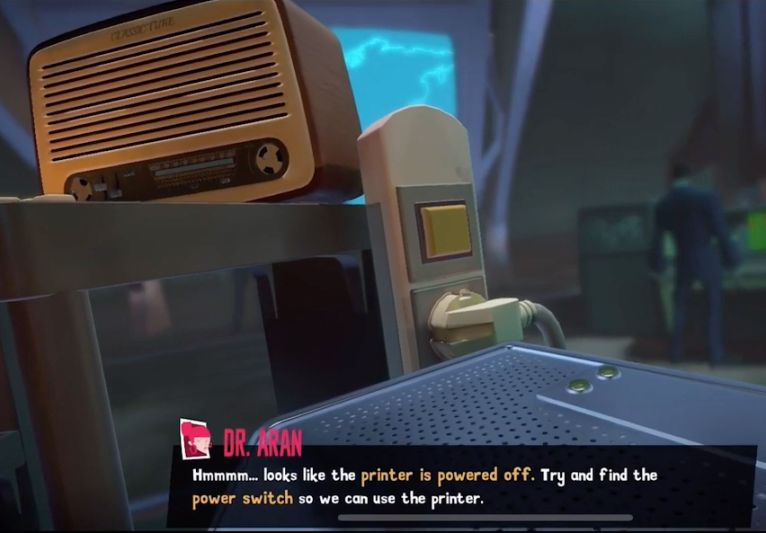 While his ultimate goal is epic, Agent 8 first needs to accomplish a much simpler task involving two steps. First: switch on the power to a printer. Second: print out hard copy of a set of secret plans. Fortunately, there's a nicely placed power strip with a big yellow button (pictured left) that activates both the aforementioned printer and a little radio simultaneously. Once Agent 8 has punched that button, the war room suddenly brightens to the sounds of a radio station offering light jazz stylings suitable for evening cocktails.
While his ultimate goal is epic, Agent 8 first needs to accomplish a much simpler task involving two steps. First: switch on the power to a printer. Second: print out hard copy of a set of secret plans. Fortunately, there's a nicely placed power strip with a big yellow button (pictured left) that activates both the aforementioned printer and a little radio simultaneously. Once Agent 8 has punched that button, the war room suddenly brightens to the sounds of a radio station offering light jazz stylings suitable for evening cocktails.
From here, Agent 8 proceeds in his dangerous mission, accompanied at all times by music suitable for a classy lounge. This poses an interesting dilemma in terms of the structure and functionality of the atmospheric music in this level. How can the background music serve to enhance Agent 8's perilous journey if it also has to compete with this urbane soundtrack?
Fortunately, the music of The War Room level was purposefully designed to combine both the diegetic content (in the form of that jazzy radio broadcast) with that same modular system of over 30 nondiegetic / incidental music segments that typifies atmospheric music from other levels. Because these two divergent  sources of music are operating simultaneously, they had to be carefully constructed so that they fit together and complement each other.
sources of music are operating simultaneously, they had to be carefully constructed so that they fit together and complement each other.
First, I composed and recorded the radio jazz piece. Knowing that this radio music would be localized in the environment and that other nondiegetic music would be layered on top, I kept the instrumentation for the radio music purposefully light and gauzy in texture. For this track I performed a solo scat-driven vocal version of Agent 8's main theme tune, accompanied by a lounge pianist delicately tickling the ivories. Because this piece would be playing for quite a long time, I composed a fairly lengthy track that transitions through lots of different retro-jazz styles, infused intermittently with latin flair ranging from bossa nova to tango. The goal was to introduce a sense of evolving variety to the piece while still reinforcing the jazz-lounge vibe. Here's what it's like when Agent 8 inadvertently turns on the radio and the music starts. Notice what happens in the music when Agent 8 crawls down and pushes the button on the printer.
You'll notice that when the printer is activated, the solo piano and voice are suddenly joined by more instruments, including a vibraphone and guitar. This is one of the many concise music segments that are triggered throughout the War Room level, and this music system bears a lot in common with the modular dynamic system from the Space Invaded level. Both involve over 30 discrete music files that are triggered in a semi-random order according to the state of play. As the level proceeds, the segments grow in their complexity to heighten the drama. However, for the War Room, these segments are associated with specific points in the diegetic "radio jazz" track. The music system triggers these segments in a staggered, unpredictable fashion. If the game engine determines that circumstances warrant the triggering of another segment, the dynamic music system calls up one of the two segments associated with that specific point in the diegetic track. Depending on the player's progress throughout the level, the music system triggers either the subtle or more dramatic musical segment. The system also has the virtue of being able to let the music settle back, removing the orchestral instrumentation to leave only the "radio jazz" duet of piano and voice. Here's a video that demonstrates this dynamic music system in action:
You'll notice that in the above video, Agent 8 pauses before turning the keys to unlock the security box, and the music refrains from triggering any of the non-diegetic segments during this pause. Then when the security box swings open, the music swells with the addition of woodwinds, vibraphone and harp.
The resulting dynamic music model for The War Room is an eclectic mix of dynamic music techniques. Some principles from both Horizontal Re-sequencing and Vertical Layering are on display here, but the music interactivity of The War Room doesn't truly adhere to either of those well-established systems. The audio team at Sumo Digital and I approached this ambitious music design with careful planning and tight organization, so that the resulting web of musical components would fit comfortably together and dynamically enhance gameplay.
I hope you've enjoyed this discussion of some of the dynamic music functionality at work in the Spyder video game! In the next installment, we'll be moving on from the atmospheric music to take a closer look at the dynamic system for action tracks. Thanks for reading!
 Popular music from composer Winifred Phillips' award-winning Assassin's Creed Liberation score is currently being performed live by a top 80-piece orchestra and choir as part of the Assassin's Creed Symphony World Tour, which kicked off in 2019 with its Paris premiere. As an accomplished video game composer, Phillips is best known for composing music for games in five of the most famous and popular franchises in gaming: Assassin’s Creed, God of War, Total War, The Sims, and LittleBigPlanet. Phillips' other notable projects include music for the triple-A first person shooter Homefront: The Revolution (Deep Silver), and numerous virtual reality games from such accomplished developers as Supermassive Games, High Voltage Software, and Armature Studio. She is the author of the award-winning bestseller A COMPOSER'S GUIDE TO GAME MUSIC, published by the MIT Press. As a foremost authority on music for interactive entertainment, Winifred Phillips has given lectures at the Library of Congress in Washington DC, the Society of Composers and Lyricists, the Game Developers Conference, the Audio Engineering Society, and many more. Phillips’ enthusiastic fans showered her with questions during a Reddit Ask-Me-Anything session that went viral, hit the Reddit front page, received 14.9 thousand upvotes, and became one of the most popular gaming AMAs ever hosted on Reddit.
Popular music from composer Winifred Phillips' award-winning Assassin's Creed Liberation score is currently being performed live by a top 80-piece orchestra and choir as part of the Assassin's Creed Symphony World Tour, which kicked off in 2019 with its Paris premiere. As an accomplished video game composer, Phillips is best known for composing music for games in five of the most famous and popular franchises in gaming: Assassin’s Creed, God of War, Total War, The Sims, and LittleBigPlanet. Phillips' other notable projects include music for the triple-A first person shooter Homefront: The Revolution (Deep Silver), and numerous virtual reality games from such accomplished developers as Supermassive Games, High Voltage Software, and Armature Studio. She is the author of the award-winning bestseller A COMPOSER'S GUIDE TO GAME MUSIC, published by the MIT Press. As a foremost authority on music for interactive entertainment, Winifred Phillips has given lectures at the Library of Congress in Washington DC, the Society of Composers and Lyricists, the Game Developers Conference, the Audio Engineering Society, and many more. Phillips’ enthusiastic fans showered her with questions during a Reddit Ask-Me-Anything session that went viral, hit the Reddit front page, received 14.9 thousand upvotes, and became one of the most popular gaming AMAs ever hosted on Reddit.
Follow her on Twitter @winphillips or visit her website at winifredphillips.com.
Read more about:
Featured BlogsYou May Also Like